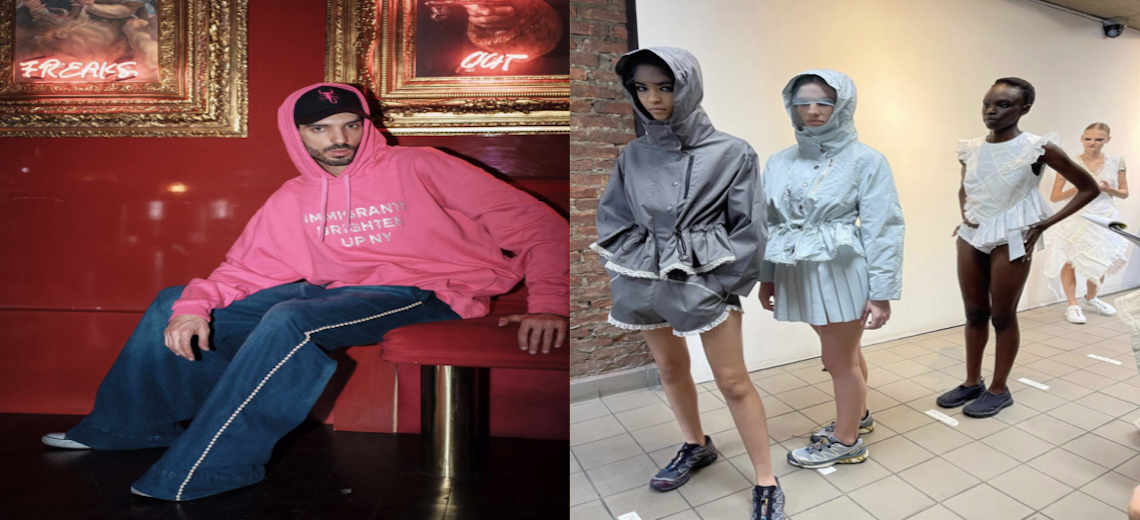Covid-19 catalyzed the breakdown of the walls surrounding the runway at New York Fashion Week this year, in more ways than one.
This season, an increasing number of shows steered away from the traditionally enclosed studio setup, in favor of outdoor venues and livestreams. And on a metaphorical level, the walls of the fashion industry, which some have called out for impeding diversity, have begun to break down amid the stream of social justice movements in the past year.
“Covid opened [the fashion industry] to be more inclusive,” said Ricardo Seco, a Mexican designer who unveiled his collection on Sunday. But to Seco, “The concerns [about diversity] are not only temporary, [they’re] forever.”
On Sunday, the whirlwind past week of in-person shows and events continued with two more panels at Spring Studios: “My American Dream: Understanding the Fashion World Through the Immigrant Experience” and “Representation and Identity in the Fashion Image.” The panels were sandwiched between a lineup of minority-owned fashion brand shows. The brands — which ranged from Telfar, which describes its customer as “black-adjacent, queer-adjacent,” to Sandy Liang, a second-generation Chinese-American immigrant — served to enrich the discussions of diversity in the fashion industry.
A few miles east of Spring Studios, the last day of NYFW kicked off on Grand Street, where Liang debuted her spring 2022 collection at the Abrons Arts Center. Fittingly for the panels of the day, the iconic Lower East Side street was known prior to the 2000s for being a melting pot of working-class immigrants. That included Liang’s own parents, who emigrated from China. For Liang, the frills, lace, high necklines and pearls that underscore her designs link back to her grandmother, who was among the “Chinatown grandmothers” of her childhood. “Everything that I’ve grown up with and my family — that’s in [my] clothes, in one way or another,” said Liang. But on a deeper level, Liang attributes her work ethic to her family. “The fact that I run a small team and we’re super hard-working — it’s the mentality that’s carried over [from my family].”
Across lower Manhattan, in Chelsea, was the show of Mexico-born and -raised designer Ricardo Seco. It was centered on the theme of “Reborn”. The collection, inspired by “human resilience” post-Covid, highlighted the impact of immigrants in New York City and Latin culture, both in the designs and the models. “I represent with my models all the different types of immigrants. Everything: African, Latins, Americans, European, Asian. I choose normal people who represent immigrants. New York is a city of immigrants.”
Seco’s collection featured brightly colored, metallic fabrics, as well as phrases like “Immigrants Brighten Up NY” and “Hecho en Mexseco” [a play on Made in Mexico].
4 Questions with ManiMe’s Jooyeon Song
Ahead of the Sandy Liang show on Sunday morning, Glossy chatted with Jooyeon Song, founder of stick-on nail gel brand ManiMe. Song discussed the importance of maintaining diversity within the nail care industry and her most recent collab, with celebrity nail artist Mei Kawajiri (@nailsbymei). The models in the Sandy Liang show sported the designs.
Ad position: web_incontent_pos1
How did ManiMe come to fruition?
“My first professional career was actually [in] India. I used to work for the Hyundai Motor India Engineering center, working at an IPO (input-process-output) system and learning how to 3D model, 3D print. That experience made me think, ‘What if I 3D-modeled my nails and 3D-printed nails for getting the perfect fit?’ Because none of the ready-to-wear nails on the market worked for me. I don’t know, maybe I have a special nail shape. But nothing was giving me the satisfaction that I would experience at the nail salon. That idea led me to start this venture. I came to Stanford MBA in 2017 and met my co-founder there, and we just got started developing the technology of 3D model rendering. We built an algorithm that can detect nail size from a 2D picture and render [a] 3D model for each customer.”
How did your ‘Ferosh Queen’ design end up on the Sandy Liang runway?
“It was an interesting match. Mei actually found a signature flower [within Liang’s collection] that exactly matched the flower design of ‘Ferosh Queen.’ She [then] proposed [that we work with] Sandy Liang.”
What are your favorite nail trends this fall?
“Sheer-looking nails are definitely a trend. Like the ‘Ferosh Queen’ design, you can put a design [on top of the sheer base coat]. [The design] could be simple, but it could [also] be popping out… We just launched a nine-piece capsule that [takes] inspiration from the ’90s. [The collection includes] popping out, vibrant colors. I saw a lot of TikTok influencers using designs from the capsule and also from other companies and other nail designers. Those ’90s-inspired designs are coming out in the fall.”
Is solidarity among POC and minorities within the fashion and beauty industries important to you, given your roots in Korea and immigrant identity? How do you enforce that with ManiMe?
“We have a rule that we definitely want to make our [ManiMe] community very diverse. When I first realized we don’t have a black artist in our community, that hit me hard… We brought in a black nail artist, and we made it a rule [that] our community should represent a fair share of each POC community.”
Spotted
Wildflower Cases founders and influencers Sydney and Devon Lee Carlson snapping photos of a fellow Sandy Liang show guest: a pint-sized Chihuahua.
Overheard
“I’ve spent more money on parking than I’ve made this week. Each show takes like $50 out of my check.” –a fashion photographer at the Dennis Basso show




